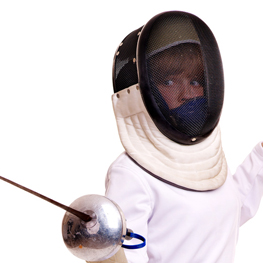
Fencing, Mixed Martial Arts and swimming - they are not as mainstream as baseball, basketball and soccer, but they may be a good fit for kids who want to participate in sports but shy away from team-focused activities. Here’s more about the benefits and safety of these diverse sports from three instructors who teach kids the same sports they grew up enjoying themselves.
On guard!
According to Jason Sheridan, founder of Sheridan Fencing Academy, fencing helps children develop their coordination, balance, concentration, strength, speed and problem-solving skills. Sheridan has started kids as young as four years old in his fencing program; however, he says most kids probably start around the age of 10 or 12.
“Our programs are designed with the understanding that youth sports need to be about kids, giving them a way to maximize their fun in order to maximize their learning,” says Sheridan. “We engage the children’s minds so that they can enjoy themselves more, learn more and are then eager to excel.”
“One of the greatest benefits is as the child gets older, goal-setting becomes an important component of training,” says Sheridan. “We have students who go from being these shy, timid children to really confident people who recognize their ability to transform themselves through the work they do.”
Sheridan adds that he considers fencing one of the safest sports in the world. Equipment is designed to keep the fencers safe, and rules and practices allow for intense exercise while maintaining a safe environment.
Sheridan has competed internationally and earned his Fencing Masters degree at the Academy of Physical Education in Katowice, Poland, one of the most prestigious fencing training programs in the world.
Osu!
“In an age of fast food and video games, Mixed Martial Arts (MMA) provides children with a healthy outlet for their energy,” says Sensei Jose Montes, head instructor and owner of Tiger Schulmann’s MMA Monroe-Woodbury. “And in the process of teaching kids about self-defence, we help them stay fit and healthy.”
MMA is a hybrid style of martial arts that aims to prepare students for real life self-defence situations. In the process of learning the sport, MMA engages all three aspects of a physical conditioning program: strength, cardiovascular conditioning and flexibility.
Montes started in martial arts at the age of four by training under his father who was an Olympic coach for the Puerto Rican judo team. By the age of eight, he was a National Caribbean Judo Champion. Now he is training his own children in MMA.
“[MMA] is a life skill and an art form,” he says. “You can take it to any level you want with the proper leadership and guidance.”
Take your mark!
“Swimming is a great way for kids to stay active,” says Penny Sorbello, Head Coach of the Cornwall Sea Dragons, a not-for-profit competitive swim team designed to meet the needs of both beginning and competitive swimmers ages six to 18. “From babies to teens, all you have to do is watch kids around any body of water to see the outright enjoyment.”
Accordiing to Sorbello, swimming works your cardiovascular system without the stress, pounding and risk of injury that other sports might expose kids to. And it is often linked with running and biking due to the cardiovascular demands that it places on an individual.
A child doesn’t need to be a ‘star’ swimmer to begin. However, it is helpful to know all four competitive strokes and, although teams vary, most age group teams provide opportunities for novice swimmers. Swimming competitively can begin as early as age six.
“All you need is a safe body of water to do it in and a bathing suit,” says Sorbello. “Kids don’t need any special equipment once they have attained ‘water-safe’ status.”
Swimming requires dedication, focus and patience, and is a wonderful platform for kids to learn many life lessons as well as stay healthy and fit. Sorbello lists the benefits of swimming that she sees with her own daughter as an increased ability to concentrate, increased confidence, better mood and better sleep patterns, along with the notorious voracious ‘swimmer’s appetite.’
“Kids staring at a black line for hours on end might seem boring to some, but it strikes a resonant chord with others,” she says. “The swimming pool can be almost like a protected world where they can get lost in their own ruminations and process their day while still getting exercise.”
Sorbello, who is an ASCA Level III Certified Coach, Swimming Coach and a USAT Level I Certified Coach, emphasizes that swimming is truly a lifelong sport and offers competitive opportunities at all levels.
Focus on finding the right instructor
When it comes to picking the right instructor, remember that you are establishing an important relationship for your child. The teacher you select should be someone who is an appropriate role model for your child and whose goals are in line with the goals that you have established for your child within the sport they’ve chosen. Make sure to consider the instructor’s experience in working with kids, their safety record and their teaching approach when determining if they are a right fit for your child.
Janine is a freelance writer, and a mother of three.
Calgary’s Child Magazine © 2024 Calgary’s Child